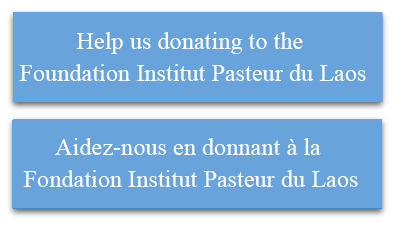Antimalarial Drug Therapeutic Efficacy Study
 Collaboration
Collaboration
Center of Malariology, Parasitology and Entomology (CMPE), Ministry of Health, Lao PDR
Savannakhet Provincial Health Department Sekong Provincial Health Department Attapeu Provincial Health Department Institut Pasteur du Cambodge, Phnom Penh, Cambodia.
Funding
World Health Organization (WHO)
Objectives
The objective of this study is to analyze blood samples (potentially containing live Plasmodium falciparum) from patients suffering from malaria to identify and map the markers of resistance to lumefantrine, an artemisinin partner drug, that is currently used in Lao PDR and many African countries for the first line treatment of malaria. In this study, the main role of the Parasitology Laboratory at IPL is to maintain the parasite alive in the clinical samples by storing the specimens in liquid nitrogen. The specialized laboratory tests are conducted at the Institut Pasteur du Cambodge (IPC).
Background
Malaria has long been one of the most medically important parasitic diseases in the Greater Mekong Sub-region (GMS) including Lao PDR. Morbidity and mortality of malaria have significantly decreased in the GMS over the last decade due to extensive efforts by the governments, partners and international organizations, such as WHO, Global Fund, Bill & Melinda Gates Foundation [1]. The Lao Ministry of Health adopted an ambitious goal to eliminate P. falciparum malaria by 2023 and all forms of human malaria by 2030. Artemisinin-based combination therapy (ACT) has been used for malaria treatment worldwide. In Lao PDR, Coartem (artemetherlumefantrine), one of the ACTs, has been used for the treatment of P. falciparum malaria since 2004. However, partial clinical artemisinin resistance (or delayed parasite clearance) in P. falciparum was first reported in Pailin, in the western part of Cambodia, in 2009 [2] and gradually spread or emerged in the neighboring countries, which is a serious threat to malaria control and elimination in the GMS and globally. Mutations of the kelch13 gene (k13) in P. falciparum are associated with artemisinin resistance and are currently used as a molecular marker for monitoring its resistance [3]. On the other hand, an antimalarial drug therapeutic efficacy study (TES) conducted by CMPE demonstrated that 10%-14% of cases were artemisinin resistant in 2013-2017 [1]. These TES results, together with the prevalence of the k13 mutations suggested that the efficacy of Coartem is slightly decreasing and the partner drug, lumefantrine, is the main actor in clearing malaria parasites in the patients. However, no molecular marker for lumefantrine resistance has been identified so far.
Methodology
The study sites of this project are at public hospitals (provincial hospitals and district hospitals) in malaria-endemic areas in Savannakhet, Salavan and Champasak provinces in 2019-2020 and Savannakhet, Sekong and Attapeu provinces in 2021-2023. Live P. falciparum samples were collected from malaria patients who participated in this study. The collected samples (approximately 2mL of fresh blood sample in EDTA tube) were sent to IPL in a Thermos bottle with iced water by public bus or shipping company, and erythrocytes were preserved in liquid nitrogen with freezing solution. The selected cryopreserved P. falciparum samples were sent to IPC with dry ice in May 2023. Ethical clearance for this study was obtained by CMPE from the National Ethics Committee for Health Research, Lao Ministry of Health. Informed consent was obtained from the study participants. The material transfer agreement was signed by CMPE, IPL and IPC.
Results
Ten samples containing live P. falciparum (2 treatment failure cases and 8 normal cases as a control) were sent to IPC. They were analyzed by in vitro drug susceptibility tests and genomic analyses to identify molecular marker(s) of lumefantrine resistance and some other drug resistances at IPC.
Conclusion & Perspectives
The results of the TES study will be utilized for updating the National Treatment Guideline for Malaria in Lao PDR, especially for P. falciparum treatment.
References
1. World Health Organization, World Malaria Report 2019, Geneva: World Health Organization, 2019. 2. Dondorp AM, Nosten F, Yi P, et al. Artemisinin resistance in Plasmodium falciparum malaria. New England Journal of Medicine, 361(5): 455-467, 2009. 3. Ariey F, Witkowski B, Amaratunga C, et al., A molecular marker of artemisinin-resistant Plasmodium falciparum malaria, Nature, 505(7481): 50-55, 2014.






